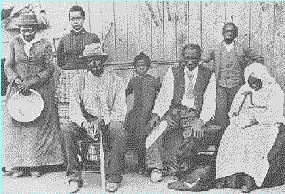Harriet Tubman
African-American Abolitionist (1820-1913)
Born
Araminta Green, a slave in Maryland, Tubman escaped from bondage in 1849, and went on to
adult notoriety as the Underground Railroad’s preeminent conductor. In her sixth year, young Harriet was removed from her family to work
for a neighbor, and by the age of ten she had served a number of masters who scarred her
body with numerous whippings. While still ten years old, Harriet was present when a
runaway slave was caught while making his escape. She refused to tie the slave up and the
slave successfully escaped. As punishment, she was hit in the head with a heavy stone. The
blow took several months to recover from and it caused her to suffer severe headaches for
the rest of her life.

Harriet Tubman (at left) with some of her charges.
Photo from
the Bettman Archive, Inc.
When Harriet became aware
of the infamous railroad, she recognized the hope that it held out to all slaves. 1844
brought a marriage union to John Tubman, a free slave, who respected Harriet’s wishes
for freedom, but did not wish to endanger their relationship, and lives, by conveying her
to freedom as a fugitive on the Railroad. (The marriage of a slave to a free man did not
make the slave free). After being removed from her husband and being sold to a slave
trader in 1849, she planned and executed an escape that took her via the Railroad to
Pennsylvania where she joined, in December, 1850, the valiant men and women who served as
Underground Railroad conductors.
Putting her
personal freedom and life in jeopardy she returned to the South on 19 occasions to rescue
and conduct fugitives to northern states and liberty. She was tough and determined, and
allowed no dropping out or returning to the South. With black kidnappings in the North
increasing and fugitive slaves facing increased scrutiny, she led 11 trips to Canada. On
one such occasion, a despondent fugitive was prepared to surrender, however, Harriet, with
other plans, drew a pistol and ordered him to "Move or die." The entire
party reached Canada safely.
Hundreds of former slaves, who called her
"Moses," secured their freedom with Harriet’s assistance and courage. After
guiding more than 300 slaves to safety, Southern slave owners offered a bounty of $40,000
for her capture. She lived to share the stage, as a guest speaker, with the likes of
Elizabeth Cady Stanton and Susan B. Anthony in the quest for women’s suffrage, and
control of property and wages.
After giving unselfishly to others for most of her adult
life, she spent her last few years in poverty; dying at the age of 93 in Auburn, New York,
on March 10, 1913.
'Black History' segment
written in June, 1998 by David Lodge
[ Back to Black History Index ]
|

